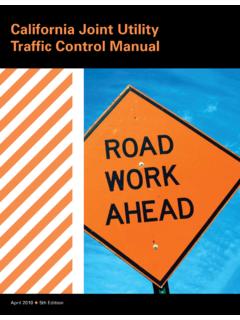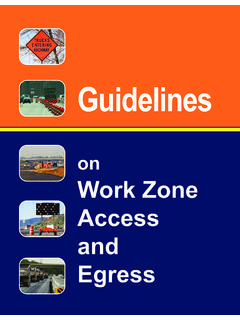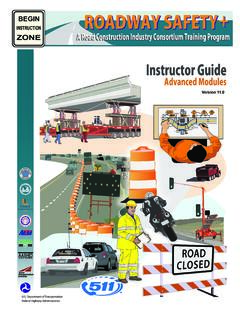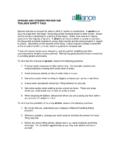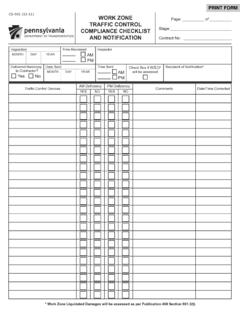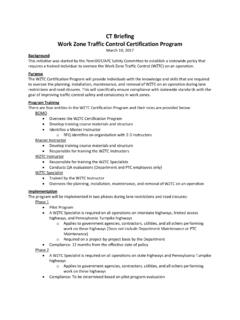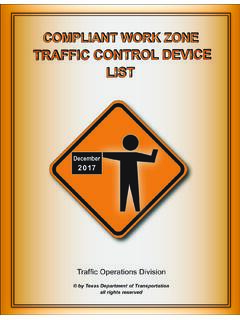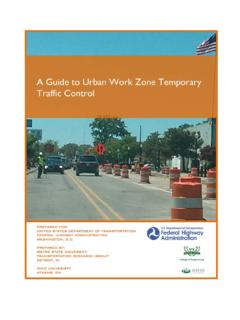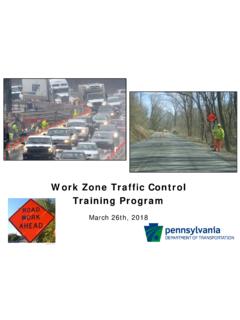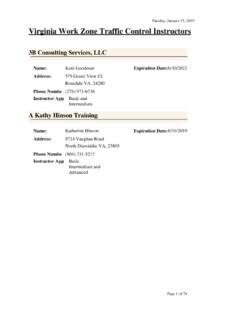Transcription of Developing Internal Traffic Control Plans for Work Zones
1 GuidanceMarch 2016 work Zone Safety ConsortiumThis material is based upon work supported by the Federal Highway AdministrationGrant Agreement DTFH61-II-H-00029 Developing Internal TrafficControl Plans (ITCPs) for work Zones PrefaceWhile the use of Internal Traffic Control Plans (ITCP) in work Zones is not regulated by the Department of Transpor tation, Federal Highway Administration (FHWA) or by the Department of Labor, Occupational Safety and HealthAdministration (OSHA), adoption of an ITCP approach is an effective method of organizing the work space to reduce workzone injuries and fatalities. The concepts described herein are best practices gathered and evaluated by governmentresearchers and private contractors who have studied ITCPs for nearly two decades. ITCPs align with regulations issued by both FHWA and OSHA that require development and execution of safety programsfor construction workers.
2 For example, the national Manual on Uniform Traffic Control Devices(MUTCD)1contains thefollowing description in Section Fundamental Principles of Temporary Traffic Control : Road user and workersafety and accessibility in temporary Traffic Control (TTC) Zones should be an integral and high priority element of everyproject from planning through design and construction. ObjectivesThis document explains the concept of Internal Traffic Control Plans or ITCPs, as applied in roadway construction workzones. Construction contractors, contracting agencies, and others responsible for work zone safety face the challengeof providing a safe workplace while ensuring the safe movement of all road users through and around the work concept of an ITCP involves coordination of construction Traffic inside the activity area of a TTC zone.
3 The purposeof an ITCP is to separate to the extent possible work vehicles and equipment from workers on foot. Those involved in roadway construction are likely familiar with temporary Traffic Control Plans (TTCPs), which describehow a specific work zone is to be set up to ensure the safety of the motoring public. However, workers, vehicles, andequipment within the work space are usually not addressed in the TTCP. The ITCP is a plan that project managers andothers who have production responsibility for roadway construction projects can use to coordinate and Control the flow ofwork vehicles, equipment, and workers operating in close proximity within the work document is organized into the following sections: ITCP Defined Need for ITCP ITCP Components Steps in Developing an ITCP Other Considerations Example ITCP Diagrams of Typical work Operations and Worker Safe Zones Regulatory Background _____Refer to a copy of this document.
4 2016 American Road and Transportation Builders Association, Washington, DCThis material is based upon work supported by the Federal Highway Administration under Grant Agreement No. DTFH61 II H opinions, findings and conclusions or recommendations expressed in this publication are those of the author(s) and do not necessarily reflect the view of the Federal Highway Administration. This publication does not constitute a national standard, specification, or regulation. No statement made in this booklet should be construed to convey an impression that any memberof the consortium, its affiliates, or employees have assumed any part of the employer s exclusive legal responsibility for providing a safe and healthful workplace as mandated by the Occupational Safety and Health Act. Nor does mention of trade names, commercial products, or organizations imply endorsement by the Internal Traffic Control Plans (ITCPs) for work Zones Internal Traffic Control Plans DefinedAn ITCP is a method or protocol to coordinate worker, work vehicle, and equipment movements in the activity area of awork zone and to inform all parties operating within the activity area about the locations of others.
5 The activity area is thesection of the highway where the work activity takes place. It is comprised of the work space, the Traffic space, and thebuffer space. The ITCP goal is to minimize interaction between workers on foot and work vehicles and equipment. ITCP salso serve to reduce backing and other maneuvering by large trucks in the activity movement of workers, vehicles, and equipment within the work space should be planned in a manner similar to theway a TTCP (temporary Traffic Control plan ) guides road users through the work zone. Whereas TTCPs focus on movingmotorists safely through a work zone, ITCPs focus on keeping workers on foot from being struck by work vehicles and equip ment within the work space. TTCPs and ITCPs share common principles, including: providing clear direction about the proper travel path to follow, separating moving vehicles from workers on foot, using TTC (temporary Traffic Control ) devices to mark Traffic paths, and maintaining a smooth Traffic help accomplish these functions by.
6 Designating safe areas for workers and appropriate routes for work vehicles and equipment, establishing no go Zones for workers as well as for work vehicles and equipment, and defining specific operating procedures for trucks delivering materials in the activity for Internal Traffic Control PlansEach year, 50 to 60 highway workers are killed and thousands more are injured when struck by vehicles or equipment atroad construction some of these fatalities are caused by motorists not paying attention or driving recklesslyor impaired and intruding into the work space, an equal number of fatalities occur when work equipment or vehicles driveover or back over a help protect workers on foot in the workspaces of an activity area. Because workers on footoften must work close to large vehicles and equip ment, the movements of workers, equipment, andvehicles must be well coordinated.
7 The hazard ofproximity to equipment and vehicles is compoundedby blind spots. A blind spot (or blind area) is the areaaround a vehicle or equipment that is not visibleto the operator, either by direct line of sight orindirectly by use of Internal and external vehicle has its own unique blind spots. Whena worker on foot enters a blind spot, the workeris virtually invisible to the also help reduce risks for vehicle and equip ment operators by identifying hazardous locations( , drop offs, overhead power lines, etc.) and safetravel paths around the job ITCP can use TTC devices to marktravel paths (Source: FOF/Kojadinovish).Fatal Injuries at Road Construc on SitesVEHICLE TYPEC ranes and Li sGraders and RollersLoaderBulldozerBackhoeConstruc onDump TruckPickup TruckTractor TrailerVanAutomobile0 100 200 300 400 500 600 Source: Department of Labor Bureau of Labor Sta s cs: Fatal occupa onalinjuries at road construc on sites by selected characteris cs, 2003 - 201031907418011193123155532 ITCP Components The main components of an ITCP are: ITCP diagrams, ITCP legend, and ITCP heart of the ITCP is the diagram showing the layout of thework space and the movement of personnel and constructionvehicles within the work space.
8 The ITCP will include the access and egress points for the work space, so it may also show portions of the overall work zone. While thediagram does not have to be to scale, it should beadequate to give those reviewing the plan a goodconcept of how the safety features will ITCP legend explains the symbols used on the ITCP diagram. Standard symbols for devices andvehicles can be based on those used in the national MUTCD, if desired. However, additional details on classes of personnel( , spotters, other workers) and vehicle types are needed in Developing an ITCP. In many cases, simple hand drawn sym bols are adequate such as those for the dozers, spotter, and dump trucks in the hand drawn example ITCP notes contain safety points, injury reduction measures, site specific provisions, and duties of various contractorpersonnel.
9 The ITCP notes should include provisions for communication between workers, assignment of spottersfor backing trucks and equipment, and site speed some ITCPs can be fairly informal and quickly implemented as part of thedaily work shift safety briefing (see example to the left), others may need to bemore extensive and involve several hours of staff time to develop and method of getting the information out to workers should be covered in thecommunications plan (see Step 8 on page 9). The level of detail included in anITCP should be consistent with the size of the project and the number andfrequency of worker safety risks that will exist. For example, items that maybe included in the ITCP notes and diagrams for a more complex jobsite mightinclude the following: contact information for the general contractor and all subcontractors, designated worker and visitor parking areas, procedures for orienting independent truck drivers to the activity area/ work space and ITCP, delineated areas around specific equipment and operations where workers on foot are prohibited, designated locations for storing materials and servicing equipment, schematic diagrams depicting movement of workers on foot, work vehicles, and equipment within the activity area, descriptions of Internal signs and other Internal Traffic Control devices that will be used, speed limit for operating vehicles and equipment within the activity area, specifications for any lighting that will be required in the activity area.
10 Description or drawing of how the ITCP relates to the TTCP, a training plan about the ITCP for all site personnel, and an operations communications plan including how the ITCP will be monitored and enforced (the development ofthis plan is discussed in greater detail in the following section). The above ITCP diagram includes a legend and notes (Sources:ARTBA and FOF Communications clipboard drawing below: FOF).Steps in Developing an ITCPThe following section describes an 8 step approach that canbe followed to achieve a safe and effective 1. Identify project and ITCP , the ITCP should be considered from the very beginning of aproject because some important elements such as the size of thework space will be dictated by such things as the amount ofright of way available and the number of lanes that will be facilitate proper separation between workers on foot and therequired work vehicles and equipment, adequate space is such considerations are not anticipated from the beginning, it willbe more difficult to organize a complete ITCP.

